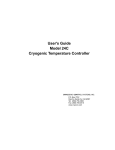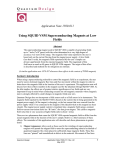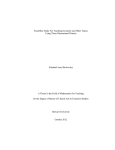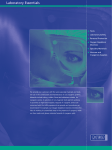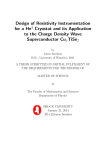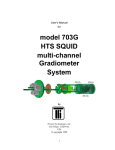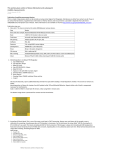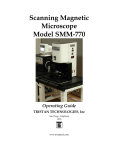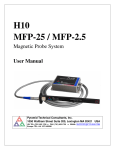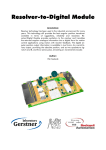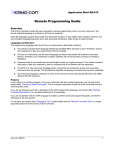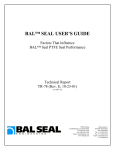Download blue dewar thesis
Transcript
blue dewar thesis Daniel Swetz 17 May 2002 Contents 1 Introduction 5 2 Superconductivity 2.1 Meissner effect . . . . . . . . . . 2.2 The Josephson Junction . . . . . 2.3 SQUIDS . . . . . . . . . . . . . . 2.3.1 DC SQUIDs . . . . . . . . 2.3.2 DC SQUID Operation . . 2.3.3 Quantum Design’s SQUID 3 Cryogenics 3.1 Outside Cover . . . . . 3.1.1 Inner Shielding 3.1.2 Heat Switch . . 3.2 Cooling . . . . . . . . . . . . . . . . . . . . . . . . . . . . . . . . . . . . . . . . . . . . . . . . . . . . . . . . . . . . . . . . . . . . . . . . . . . . . . . . . . . . . . . . . . . . . . . . . . . . . . . . . . . . . . . . . . . . . . . . . . . . . . . . . . . . . . . . . . . . . . . . . . . . . . . . . . . . . . . . . . . . . . . . . . . . . . . . . . . . . . . . . . . . 6 6 8 10 11 13 14 . . . . 18 18 19 20 21 4 TES Testing 31 4.1 Testing . . . . . . . . . . . . . . . . . . . . . . . . . . . . . . . 31 4.2 Conclusion . . . . . . . . . . . . . . . . . . . . . . . . . . . . . 32 2 List of Figures 2.1 2.2 2.3 2.4 2.5 2.6 2.7 2.8 2.9 Equivalent circuit for a resistively shunted Josephson junction A tilted washboard model for solutions to 2.7 with I < I0 . In this case the particle is confined to a potential well where it will oscillate back and forth. . . . . . . . . . . . . . . . . . . . Tilted washboard model with I > I0 . The tilt has increased to the point where the ball can roll down the washboard. Now < δ̇ > is no longer zero and so a voltage will appear across our Josephson junction. . . . . . . . . . . . . . . . . . . . . . V vs. φ which shows the d.c. value and the a.c. oscillation superimposed upon it. If The junction is biased in the steep part of the curve, then small changes in flux will lead to large changes in voltage. . . . . . . . . . . . . . . . . . . . . . . . . A magnetic flux, φ generates a periodic supercurrent in the ring which is periodic with φ0 . . . . . . . . . . . . . . . . . . Critical current Ic is periodic with φ0 . . . . . . . . . . . . . . A simple flux modulated feedback circuit for a DC SQUID . . Circuit diagram for Quantum Design’s DC SQUID . . . . . . The control box for the model 5000 DC SQUID . . . . . . . . 3.1 3.2 The dewar when it is put together and closed up. . . . . . . . This graph shows a ramping of the magnet, starting from 2.4K. The ramping takes approximately one hour. The temperature is maintained for about three hours before the bolometer box begins to reheat . . . . . . . . . . . . . . . . . . . . . . . . . . 3.3 Bolometer box hung on 8 kevlar strings in a suspension system 3.4 Top views of the heatswitch in both the open and closed position. The peanut cam is rotated by a ratcheted solenoid, causing the copper set screws to clamp onto the salt pill. . . . 3.5 Side view of the heat switch showing the floated cam assembly 3 9 10 10 11 13 13 14 16 17 24 25 26 27 28 3.6 3.7 4.1 4.2 4.3 This graph shows the hold time for liquid helium after the first cooldown of the dewar. It takes 2 hours to come to 4.2K and the helium lasts for 7 hours. . . . . . . . . . . . . . . . . . . 29 This graph shows a ramping of the magnet, starting from 2.4K. The ramping takes approximately one hour. The temperature is maintained for about three hours before the bolometer box begins to reheat . . . . . . . . . . . . . . . . . . . . . . . . . . 30 A mounted TES device wirebonded to the pad and screwed into the holder . . . . . . . . . . . . . . . . . . . . . . . . . . 33 An inside view of the bolometer box, with the niobium can which houses the TES devices. Also shown is the stainless capillary which the superconducting wires run through . . . . 34 A theoretical transition from the superconducting to non-superconducting state. By biasing the detector in the middle of the transition, small changes in temperature lead to large changes in resistance . . . . . . . . . . . . . . . . . . . . . . . . . . . . . . . 35 4 Chapter 1 Introduction When making astronomical observations, the characteristics of your detectors is of significant importance. Often, your detector sets the upper limit on the level of detectable signal. Because of the importance of detectors to experiments, detector development is a crucial role to any experiment. Recently, a new type of detector, known as a Transition Edge Sensor detector (TES) has shown promise as having higher sensitivity and lower noise than other detectors. As in the development of any new device, many tests must be carried out before they can be used on an experiment. This work reports on the set up of a lab dewar for tests on TES devices including the SQUID read-out electronics, the cryogenics, and also some preliminary results. 5 Chapter 2 Superconductivity In order to understand how a TES detector works, and how the SQUID electronics operate, we must first establish a basic understanding of superconductivity. Superconductivity is a property which certain metals exhibit when cooled below a critical temperature, Tc . The main property of a superconductor is the lack of electrical resistance to direct flow of current [1, 2, 3]. This effect is different than the decreasing resistivity of a metal as it is cooled. Superconductivity is a quantum mechanical effect involving the breaking of local gauge invariance of the metals electrons. When the metal goes from the normal, free electron state, to the superconducting state, the metal undergoes a phase transition, in which the ground state of lowest energy is achieved by the pairing of electrons in so called Cooper pairs. The microscopic theory of superconductivity was worked out by Bardeen, Cooper, and Schrieffer and is known as the BCS theory of superconductivity. For a more detailed description see [2, 3]. 2.1 Meissner effect The second property exhibited by superconductors is the fact that they are not only perfect conductors, but also exhibit perfect diamagnetism. To understand the difference between a metal with perfect conductivity and one with perfect diamagnetism, consider a metal cooled below it’s transition temperature in the presence of an applied magnetic field. Since the resistance in the metal must be zero below Tc , the resistance around any closed path must also be zero and the amount of magnetic flux density B must not vary 6 with time, or Ḃ = 0. If a superconductor were just a perfect conductor, then it would freeze in the applied magnetic field when cooled below Tc as it has no way to expel the field. If we now replace the metal in the previous experiment by a superconducting metal, we find that the superconductor never allows a magnetic flux density to exist in it’s interior, or equivalently, B = 0 inside the superconducting metal [3]. The superconductor expels the magnetic flux by means of a supercurrent flowing on the surface and circulating in a way to exactly cancel the applied field. This is known as the Meissner effect. This supercurrent flows in a thin layer of thickness, λ(T ), and is known as the penetration depth. The penetration depth varies with temperature according to 1 λ(T ) = λ(0)/[1 − (T /Tc )4 ] 2 (2.1) It has also been shown that the flux generated by a supercurrent flowing in a superconducting ring must be quantized in order to maintain the phase of the wave function of the electrons in the superconducting state [2, 4]. The flux is quantized as φ = nφ0 with φ0 being the flux quantum and equal to φ0 = h/2e (2.2) If the external field is raised above some critical value, Hc (T), the superconductivity of the material will also be destroyed as the supercurrents needed to cancel the applied flux cannot flow in this penetration depth. The critical magnetic field is also dependent on temperature and approximately varies as Hc ≈ H0 [1 − (T /Tc )2 ] (2.3) for pure elemental superconductors, where H0 is the critical field at T = 0. Since H0 and Tc are characteristics of a given metal, it is an easy matter to calculate the critical field for a superconductor at a given temperature. With this basic knowledge we can begin to understand how some of the macroscopic effects of superconductivity will vary with temperature and applied field. Below some critical temperature, Tc , some fraction of the electrons form Cooper pairs. These pairs flow with infinite conductivity and short circuit the electrons remaining in the normal state, as any current in the superconducting metal is carried by these paired electrons. In the presence of an applied field, some fraction of the Cooper paired electrons flow on the surface to cancel the applied flux, to maintain B = 0 inside the superconductor. As the field is increased, more and more paired electrons are 7 needed to cancel the applied field. At some critical field, Hc , the number of superconducting electrons needed to cancel the flux is equal to the number present in the metal, and so there are none left to continue to short circuit the normal electrons. At this point, the metal looses it’s zero resistance and returns to its normal, non-superconducting state. 2.2 The Josephson Junction A well known effect from quantum mechanics is the fact that electrons can tunnel through barriers, if the barrier thickness is on the order of 1-2 nm. This quantum tunnelling is due to the wave nature of the electrons. Similarly, if we set up a situation in which we place a thin non-superconducting barrier between two superconductors, the Cooper paired electrons can tunnel through the non-superconducting barrier. This is what is known as a Josephson junction and is the basis of SQUID amplifiers . The equivalent circuit for such a device is shown in figure 2.1 . If a current I is applied to the junction, it will control the phase δ = φ1 − φ2 between the two junctions according to (2.4) I = I0 sinδ where I0 is the maximum supercurrent the junction can sustain and still be superconducting. The voltage-current characteristics (or the equation of motion) across the junction in figure 2.1 are then I = C V̇ + I0 sin δ + V /R (2.5) We can then use the Josephson relationship of Vdc = h̄δ̇/2e (2.6) to relate the voltage drop across the junction to the rate of change of δ to obtain I − I0 sin δ = h̄C δ̈/2e + h̄δ̇/2eR = − with potential 2e ∂U h̄ ∂δ (2.7) φ0 (2.8) (Iδ + I0 cosδ) 2π To understand how the solutions of equation 2.7 will evolve, we can make analogies to the equation of motion of a ball on a tilted washboard U =− 8 Figure 2.1: Equivalent circuit for a resistively shunted Josephson junction with potential U. In this way, the term with the capacitance is equivalent to the mass of the ball, the 1/R term is the damping term and the tilt of the washboard is ∝ −I. With this analogy, we have to cases to consider, I < I0 and I > I0 . If I < I0 , the particle is confined to move in one of it’s potential wells, and will oscillate back and forth (figure 2.2). < δ̇ > will be then be zero and so we can see from the Josephson relationship that the average voltage will be zero across the junction. If we now increase I, so that I > I0 , (so as to increase the tilt in our washboard analogy), eventually the ball will roll down the washboard (figure 2.3). < δ̇ > will no longer = 0, and so a nonzero voltage will now appear across our junction. This voltage contains both an a.c. and d.c. component, since δ̈ is not a constant as shown by the changing slope in figure 2.3. The d.c. value will be given by equation 2.6. Superimposed onto the d.c. voltage is an a.c. ripple, with a frequency of oscillation given by f= 2e 1 < δ̈ >= Vdc 2π h (2.9) as shown in figure 2.4. The basic ideas of Josephson junctions are summarized as follows. First we establish a non-superconducting barrier between to superconductors, such that Cooper paired electrons can tunnel through. If we then apply a current I > I0 a voltage will appear across the junction. This voltage will contain both a d.c. and a.c. component, with a value and frequency given by 9 equations 2.6 and 2.9. Figure 2.2: A tilted washboard model for solutions to 2.7 with I < I0 . In this case the particle is confined to a potential well where it will oscillate back and forth. Figure 2.3: Tilted washboard model with I > I0 . The tilt has increased to the point where the ball can roll down the washboard. Now < δ̇ > is no longer zero and so a voltage will appear across our Josephson junction. 2.3 SQUIDS Superconducting Quantum Interference Device’s, or SQUIDs, take advantage of two results obtained in the preceding section. First, that the flux, φ, in a superconducting ring is quantized in units of φ0 = h/2e. Second, that Cooper pairs of electrons will tunnel across non-superconducting barriers. There are two types of SQUIDs used, the RF SQUID and the DC SQUID. Both operate on the same principles just mentioned. The RF SQUID uses a single Josephson junction to interrupt the current flow around a superconducting 10 Figure 2.4: V vs. φ which shows the d.c. value and the a.c. oscillation superimposed upon it. If The junction is biased in the steep part of the curve, then small changes in flux will lead to large changes in voltage. loop and is radio frequency flux biased. DC SQUIDs use two Josephson junctions in parallel in a superconducting loop and operate at a steady bias point. I will only mention RF SQUIDs, as we only worked with a DC SQUID in our experiment. For more details about RF SQUIDs see [3, 5]. 2.3.1 DC SQUIDs The basic DC SQUID consists of a superconducting ring, interrupted with two Josephson junctions as shown in figure 2.7. If we apply a current I > 2I0 (where I0 is the critical current for each junction), the voltage across the Josephson junctions will be periodic in flux. To see why this is, recall equation 2.9, and substituting in φ0 , we see that φ0 f = V 11 (2.10) or that the voltage across a Josephson junction oscillates with period φ0 . If a superconducting loop with a Josephson junction is biased so that the voltage is on the steepest part of the V vs.φ curve, then a small change in flux leads to a large change in voltage (figure 2.4). To gain further insights as to how the SQUID operates, we will assume that both junctions are identical and symmetric about the loop. If we start with no applied flux, then no supercurrent will circulate around the loop and the bias current will divide equally between the two junctions, I = I1 + I2 = I/2 + I/2. Now apply an external flux, φ. The superconducting loop will generate a supercurrent J to cancel the external flux φ. φ (2.11) L where L is the inductance of the loop, and this current will be quantized as φ = nφ0 (figure 2.5). The supercurrent will add to the bias flowing through junction one and subtract from that flowing through junction two. The critical current will be reached in junction one when J =− I0 = I1 + J = I/2 + J (2.12) The current flowing in junction two then becomes I2 = I/2 − J = I0 − 2J (2.13) When I = 2I0 − 2J, the current flowing in the second junction will be the critical current, I0 , and so a voltage will appear across the SQUID junctions. If φ is increased to φ = φ0 /2 the supercurrent increases to J = φ0 /2L. Our critical current for the junctions will then become Ic = 2I0 − φ0 L (2.14) If we continue to increase the flux, φ > φ0 /2, the SQUID will flux jump from the n = 0 to n = 1 flux state. As the flux is increased to φ = φ0 the supercurrent goes to zero and the critical current becomes Ic = 2I0 . With this we can see how both the supercurrent and critical current oscillate as a function of φ0 . (see figure 2.5 and 2.6). The voltage change across our SQUID, in going from 0 to φ0 /2, becomes ∆V = Rt ∆I φ0 R = ∆t L 2 12 (2.15) where Rt is the total resistance of the two junctions in parallel and equal to R/2. Finally, we can see that the change in voltage per change in flux is Vφ = ∆V R = ∆φ L (2.16) This is a very simple result, and correct if both junctions are identical. The problem for many years was in making similar Josephson junctions. This problem has since been solved do to advances in lithography, and so DC SQUIDs are now commercially available. Figure 2.5: A magnetic flux, φ generates a periodic supercurrent in the ring which is periodic with φ0 Figure 2.6: Critical current Ic is periodic with φ0 2.3.2 DC SQUID Operation In most applications, a DC SQUID is placed in a flux modulated feedback circuit. A simple feedback and modulation SQUID circuit is shown in figure 2.7. 13 Figure 2.7: A simple flux modulated feedback circuit for a DC SQUID First the SQUID is biased so that a voltage appears across the Josephson junctions. An oscillator then applies a modulated flux to the SQUID via a modulation coil. The modulation should be between zero and φ0 /2. The frequency of oscillation is then sent into a lock-in detector. The SQUID produces an output signal which is then detected through a transformer and sent into the lock-in, after going through an amplifier. The signal is then sent through an integrator and connected back to the modulation coil, with a large feedback resistor, RF . This allows the SQUID bias point to be maintained by negative feedback and is often referred to as a flux-locked loop [3, 5]. If there is not a change in φ, the lock-in will produce a smooth output, and no voltage will appear across the feedback resistor. If a small flux, δφ, is applied to the SQUID, the feedback circuit will produce an opposing flux, −δφ, and a voltage proportional to δφ will appear across the feedback resistor. With this circuit small changes in flux much less than a flux quantum, δφ ¿ φ0 , can be measured. 2.3.3 Quantum Design’s SQUID We have installed a Quantum Design Model 5000 DC SQUID to be used as part of the readout electronics in our lab test dewar. The feedback circuit for their DC SQUID is shown in figure 2.8 [6]. It is very similar to the flux-locked loop shown in 2.7. The DC SQUID system returns an output 14 voltage which is proportional to the input current, Iext . If the SQUID is to be used as a readout electronics for a detector, one must know what this input current is, as this is your signal. For the Quantum Design DC SQUID, the voltage and current are related by Vout = GAIN ∗ Wmod RF B GAIN Wmod Iext = ∗ 2.5M Ω ∗ Iext ∗ WIn RAN GE WIn (2.17) where Wmod and WIn are the coupling of the modulation and input coils to the SQUID and have units of [Amps/φ0 ] with values measured and provided by Quantum Design. RF B is the feedback resistor and is equal to RF R = 2.5M Ω . The GAIN and RANGE are set by the user on the SQUID’s readout RAN GE controller. A block diagram of the inner workings of the readout controller is shown in figure 2.9. In order to test equation 2.17 and calibrate our SQUID amplifier, we set up a simple circuit with a test and shunt resistor connected in parallel. An external current, supplied by a battery and load resistor, was then sent to the two parallel resistors. The current which went across the test resistor was then sent to the SQUID and the voltage was read out. Therefore, we knew Iext and measured Vout . Unfortunately, the covering on the superconducting wires connecting the test resistor to the SQUID was scrapped away, so we had a grounding problem which prevented us from knowing Iext and verifying equation 2.17. 15 16 17 Chapter 3 Cryogenics In order to successfully test and characterize TES devices, they must be cooled through their transition temperatures. This drives the need for a reliable test dewar, which is capable of cooling to temperatures below those of the transition temperature of the TES detector, (typically between 150-350 mK). The demands placed on our cryostat were as follows: The temperature of the cryostat needs to be controlled so that you can force the TES through its transition in a controlled way. We also wanted a test dewar which is relatively fast and easy to open and close, so as not to loose much time in this process. Reliability is also a concern, so that the cryostat does not need to be opened do to some internal failure. Finally, long hold times are desirable. We have tried to realize most of these requirements by modifying the MSAM II flight dewar (also known as the Big Blue Dewar) into our lab test dewar. In the following sections, I will lay out the basic design of the test dewar starting with the 300 K outside shell and work inwards to the ADR. 3.1 Outside Cover The outside shell of the dewar consists of three parts; the top plate, a ’window’ section, and a large outer cover. The top plate has three feed through’s. Two of these lead to the liquid helium tank. The reason for two is safety, in the event that an ice plug forms in one of the feed through’s you would not be in danger of exploding the dewar. The other remaining feed through leads to the liquid nitrogen tank. 18 The top plate is connected to the ’window’ section by means of an indium sealed groove. The window section is called such, because it contains eight windows into the dewar. These windows are sealed off with blank pieces connected to the dewar by an indium seal, which allow us to penetrate into the cryostat’s vacuum. Of these blank pieces, five are currently used. Two of them are used to read out our signal and housekeeping wires, by means of a hermetically sealed military connector. One is connected to a valve which allows us access to a pump and then to leave the dewar under vacuum. Another one is a safety pressure valve. The final blank is the SQUID’s flexible probe cable. The cable has a leak tight square connector, with a short circular section at the bottom end of the connector, which needs to come out of the cryostat. Originally, we attempted to connect the cable by means of an O-ring around the circular section. The use of an O-ring is recommended by Quantum Design for vacuum tight feedthrough out of your dewar. Unfortunately, we found this method to be unreliable and insufficient. Instead, we replaced the O-ring with a nylon swage lock around the cable and an NTP pipe fitting on the other end which screws into a tapped hole on one of the window blanks. The nylon swage was used as to not deform the cable, as metal swages can do. Also, if the fitting ever has to be replaced, it is a simple matter to remove the nylon piece and replace it. We have experienced no leaks in the window section since the replacement of the swage lock on the SQUID cable. Under normal operating conditions, the top plate and window section remain connected to one another. The outer shield mates to the bottom section through either an indium seal, or an O-ring. The indium seal provides better rf-filtering, but is time consuming to put into place. As the outer shield must be removed after every cool down, the O-ring is almost always chosen. The closed dewar is shown in figure 3.1 3.1.1 Inner Shielding The dewar has two inner shields, one attached to the 77K shield and another attached to the 4K shield. Both shields are made of 3000 series aluminum and coated in aluminum foil. These shields greatly reduce the power loaded onto the cold stage by radiation. One problem with the shields is that there is very little room between the two shields. When closing the dewar up for a test, one must be careful to not have a touch between these shields. To test for touches, we have used a ’paper test’, which the shield spacing must pass. 19 This is simply taking a sheet of paper and putting it between the two shields and moving it around the shields. If there are no touches, then one should be able to do this easily. Sitting on the coldplate (the cold plate is the top of the liquid helium tank) sits the bolometer box. The bolometer box is hung with 8 kevlar strings, so as to isolate it from the helium bath (figures 3.2, 3.3). Also on the coldplate is the salt pill. It to, is hung on a suspension system to allow it to be thermally isolated [7]. Connection to the helium tank, for both the salt pill and bolometer box, is made through an internally driven mechanical heat switch. 3.1.2 Heat Switch The heat switch is an important part of any cryostat, as it allows connection and isolation of the ADR to the temperature bath. As we have an internally driven heat switch, if it breaks during a cooldown, you are forced to open the dewar to fix it, which wastes much time. Since it has been the source of much agony, I will go into some detail on how it works, and, more importantly, how to fix it. The heat switch is operated by two pivoted stainless steel lever arms which open and close around the salt pill. A rotary solenoid is connected to a peanut shaped cam, such that when the cam is in the closed position the arms clamp onto the salt pill, and when it is rotated 90 degrees it no longer clamps the salt pill and is in the open position. The cam is rotated by the pulsed solenoid by passing one amp of current through it, thus opening and closing the heat switch. After the solenoid has been pulsed, a return spring rotates the solenoid drive shaft back to the initial position. A ratchet between the drive shaft and cam prevents the heat switch from returning to the initial position (see figure 3.4) [7]. The first difficulty with the heat switch is testing it at room temperature. The heat switch leads have a resistance of approximately 110 Ω at room temperature. In order to test and fix the heat switch one needs to generate 110 volts to get the 1 Amp of current needed to pulse the solenoid. This can be done by linking many power supplies in series. But, after a few firings of the solenoid, the resistance of the leads will go up and so more and more voltage will be needed, otherwise you must wait until the solenoid cools down. One easy way to avoid this problem is by taking the heat switch off of the dewar and placing it in a liquid nitrogen bath for fixing. This keeps the heat switch cool and the resistance of the leads down. The next problem 20 is determining how much force to grab the salt pill with. By increasing the force, you improve the thermal conductivity with the temperature bath, which then reduces cooling times. But if the force is too great, the heat switch will not be able to break the static friction and will fail to pulse. The force can be set by adjusting two copper set screws at the end of the lever arms. The screws are made of 99.99999 % copper (5N copper) to provide the best thermal contact between the salt pill and the heat switch. 5N copper is very soft, and after many firings, will start to deform. When this happens, you no longer have the ability to adjust the force with which you clamp onto the pill with. The copper screws should be replaced as soon as they begin to be deformed, to prevent this from happening. One also should keep the pivots clean and make sure they are easily rotated so they do not add any friction to the pivoting action. Most lubricants do not work at such low temperatures, so in order to maintain no friction in the pivots, one needs to rub molydisulfide powder in between the pivot joint and stainless arm. Over time, the molydisulfide powder will wear away, and so the pivots should be cleaned and re-powdered periodically. The final difficulty encountered with the heat switch is in finding a balance between the return spring and the ratchet. To find this balance, the peanut cam has been floated on a spring and placed between the ratchet and return spring as shown in figure 3.5 [7]. If too little force is on the float spring, the cam will over rotate past 90 degrees, overshooting the desired position. If too much force is placed on the spring, the cam will either undershoot the rotation and return to its initial position, or it will lock up completely, and not rotate at all. The force generated on the float spring can be adjusted by a set screw on top of the cam assembly. To find the best operating position, one should open the set screw so very little force is on the spring, causing the cam to overshoot. Then continue to increase the force on the spring slowly, until the cam no longer overshoots. Then you have found your desired operating position. Since replacing the copper set screws and cleaning the pivots, we have experience no failures of the heat switch during a cool down. 3.2 Cooling After the dewar has been closed and pumped, cooling can begin. The dewar is cooled first by a four liter liquid nitrogen tank and a nine liter liquid helium tank. The time it takes to cool the bulk material (salt pill, coldplate, etc.) of 21 the dewar to 4.2K is usually on the order of two hours. Much of the helium is lost in cooling this material. After the first cool down the liquid helium lasts for approximately 7-8 hours before running out. Figure 3.6 shows a typical first cooldown. After the first cool down, the liquid helium and nitrogen usually last for over 24 hours. If you have filled with helium and it has been over four hours and you are not at 4.2K, then there is most likely a problem with the dewar, probably either a touch between 77K and 4.2K shields, or the dewar is not leak tight. After the dewar has come to liquid helium temperature, the liquid helium can be pumped on to reach a temperature of 1.5K. To reach the mK temperatures needed, our cryostat uses an Adiabatic Demagnetization Refrigerator (ADR). ADR’s are cooled by taking advantage of the fact that the entropy of a paramagnetic salt is dependent on the magnetic field. For details on the principles of operating an ADR see [7]. The basic procedure for cycling the ADR is as follows. With the heat switch closed, the current in the magnet is slowly raised to 8 Amps, generating a 3 Tesla magnetic field around the salt pill. Since the heat switch is closed the heat generated by ramping up the magnet is dissipated to the helium bath, which is either at 4.2K or 1.5K. After the current is fully ramped, one waits until the bolometer box returns to the bath temperature. The heat switch is then opened, removing the bolometer box from the helium bath. The current is slowly removed, reducing the magnetic field until the desired temperature is reached. A typical ramping of the magnet is shown in figure 3.7. When ramping from 4.2K the dewar has been able to reach temperatures of around 250 mK. The ADR should be capable of reaching temperatures of 24 mK when ramping from a temperature of 1.5K. Unfortunately, we were never able to reach these temperatures, as the coldest we ever got to was 180 mK. There are two possible causes for this failure, either we are dumping excess power onto the bolometer box, or the salt pill has degraded over time. The excess power could be generated from a variety of sources. We have been very diligent in aluminum taping all possible sources of light leaks into our 4K shield, so we think that if excess power is the cause, it must be coming from inside the 4K shield itself. The only power sources that have been added inside the shield are the SQUID amplifier, and SQUID cable. The dewar has been cooled while the SQUID amplifier has been removed, and has still failed to cool to the desired temperatures. This leaves the cable as the remaining possible source of excess power loading. Since the cable is run from the outside of the dewar, if it is not properly heat sunk, it could be 22 the problem. We have tried to minimize the amount of cable inside the 4K shield, and still failed to reach below 180 mK. The next test we will perform is to remove the cable all together and ramp the magnet. If this proves to be the source of the excess power, then finding a better way to heat sink the cable will be necessary, as the cable is necessary for running the SQUID amplifier and cannot be removed permanently. If the cable does not prove to be the source of excess power, then the salt pill may have to be replaced. 23 Figure 3.1: The dewar when it is put together and closed up. 24 25 Figure 3.2: The open dewar. Shown is the coldplate which is the top of the liquid helium tank. Below it is the liquid nitrogen tank Figure 3.3: Bolometer box hung on 8 kevlar strings in a suspension system 26 Figure 3.4: Top views of the heatswitch in both the open and closed position. The peanut cam is rotated by a ratcheted solenoid, causing the copper set screws to clamp onto the salt pill. 27 Figure 3.5: Side view of the heat switch showing the floated cam assembly 28 Figure 3.6: This graph shows the hold time for liquid helium after the first cooldown of the dewar. It takes 2 hours to come to 4.2K and the helium lasts for 7 hours. 29 Figure 3.7: This graph shows a ramping of the magnet, starting from 2.4K. The ramping takes approximately one hour. The temperature is maintained for about three hours before the bolometer box begins to reheat 30 Chapter 4 TES Testing We have modified our test cryostat so that it is capable of testing TES devices. TES devices are superconduction bolometers that can have very high sensitivity and low noise. The transition between the superconducting and normal state in a superconducting metal is a sensitive function of the temperature. For sharp transitions, small changes in temperature can cause large changes in resistance. If the transition curve during the superconduction transition can be well characterized, then biasing the detector in the middle of this transition would make a TES detector an ideal bolometer. Figure 4.3 shows a theoretical transition curve for a TES devices, along with the biasing point. The parameter α is the sensitivity of the transition curve measured T dR under constant bias current, where α = R ( dT ). Sensitivities for TES devices can range anywhere form 100-1000 [8]. TES devices are generally voltage biased, which helps to stabilize the device by providing electrothermal feedback. The bias power is given as Pbias = V 2 /R. An increase in the power loading on the device causes the device to warm up, and the resistance to increase . This increased resistance then causes the bias power to decrease, and the detector is now self-biasing. A change in resistance through a voltage biased device will then lead to a change in current which can be read using a SQUID amplifier [9]. 4.1 Testing We have been preparing to test the characteristics of Molybdenum-Copper Bilayer TES devices. We have designed a copper pad to which a die of 31 devices can be stycast onto. This pad is then connected to a copper holder, which is screwed into a niobium can. The devices of interest are then wire bonded to copper strips on the holder, which also have wires running to a connector on the can (figure 4.1). The SQUID is mounted on the 4K coldplate, and two superconducting twisted pair wires connect the SQUID to the niobium can. Shielding is important when using superconducting metal, since stray magnetic fields can add noise to your signal. Because of this, the TES devices are placed in a niobium can (see figure 4.2). Also, the superconducting wires coming from the SQUID are run through a stainless steel capillary, which is coated in solder. The reason for using the stainless capillary is because it minimizes the power loading into the ADR. Generally, a four wire measurement is made using a lock-in amplifier and a Cryocon GRT readout to measure the R vs. T transition curves and the SQUID is used to measure the V vs. I load curves. Unfortunately at this time, we have not made any successful measurements of a TES device. We did see the superconducting transition for the leads on the Molybdenum occur at .72 mK. The device was not superconducting at 180 mK, but we were unable to cool down any further. 4.2 Conclusion We have successfully modified the MSAM II flight dewar into a lab test dewar. It has been installed with a SQUID amplifier and set up to test TES bolometers. We still need to solve the problem of cooling in the dewar and also we need to verify that the SQIUD works according to equation 2.17. After these problems have been worked out, the dewar will be a reliable system to test TES devices. 32 Figure 4.1: A mounted TES device wirebonded to the pad and screwed into the holder 33 Figure 4.2: An inside view of the bolometer box, with the niobium can which houses the TES devices. Also shown is the stainless capillary which the superconducting wires run through 34 Figure 4.3: A theoretical transition from the superconducting to nonsuperconducting state. By biasing the detector in the middle of the transition, small changes in temperature lead to large changes in resistance 35 Bibliography [1] A.C. Rose-Innes and E.H. Rhoderick. Introduction to Superconductivity. Pergamon Press, 2nd edition, 1978. [2] M. Tinkham. Introduction to Superconductivity. McGraw-Hill, Inc., 2nd edition, 1996. [3] J.C. Gallop. SQUIDS, the Josephson Effects and Superconducting Electrons. Adam Hilger., 1991. [4] T. Van Duzer and C.W. Turner. Principles of Superconductive Devices and Circuits. Elsevier North Holland, Inc., 1981. [5] John Clarke. SQUID Concepts and Systems. [6] Model 5000 dc squid controller user’s manual, 1995. [7] G. Wilson. An Instrument and Technique for Measuring Anisotropy of the CMBR. PhD thesis, Brown University, 1997. [8] Ping Tan. Developing transition edge sensor microcalrimeter for x-ray astrophysics. Master’s thesis, University of Wisconsin-Madison, Masters Thesis, 2001. [9] P.L. Richards. Bolometers for Infrared and Millimeter Waves. Journal of Applied Physics, 76:1–22, July 1994. 36




































